A Comparison of SSEBop-Model-Based Evapotranspiration with Eight Evapotranspiration Products in the Yellow River Basin, China
Abstract
:1. Introduction
2. Materials and Methods
2.1. Study Area
2.2. Data Sources
2.2.1. MODIS Data
2.2.2. Meteorological Data
2.2.3. ET Products
2.2.4. Regional Database for ET Model Evaluation
2.3. Methods
2.3.1. Framework of the Assessment of ETSSEBopYRB
2.3.2. SSEBop Model
2.3.3. Trend Analysis
2.3.4. Performance of Estimated ET
3. Results
3.1. Evaluation of SSEBopYRB-ET on a Basin Scale
3.2. Spatial Pattern Comparison between ETSSEBopYRB and Other ET Products
3.3. Trend Comparison between ETSSEBopYRB and other ET Products
4. Discussion
4.1. The Effect of Potential ET Estimation on ET Uncertainty
4.2. Influence of the Land Surface Temperature Product on ET Uncertainty
4.3. Influence of Precipitation Products on ET Uncertainty
4.4. Influence of Model Parameters on ET Uncertainty
4.5. Influence of the Basin Size on ET Uncertainty
4.6. Difference between ETSSEBopYRB and Eight Other ET Products
5. Conclusions
- (1)
- ETSSEBopYRB and the other eight ET products were able to explain 23 to 52% of the variability in WB-ET for fourteen small catchments in YRB. ETSSEBopYRB had better agreement with WB-ET than ETSEBS, ETMODIS, ETCR, and ETGLASS, with lower RMSE (88.3 mm yr−1 vs. 121.7 mm yr−1), higher R2 (0.49 vs. 0.43), and lower absolute RPE (−3.3% vs. −19.9%) values;
- (2)
- The free global ET product derived from the SSEBop model highly underestimated the annual total ET trend for the YRB. More validation regarding this product is required in other regions using site measurements (e.g., eddy covariance flux tower measurements);
- (3)
- The abnormal data in the land surface temperature products of MOD11A2 for 2015 limited the performance of the SSEBop model at the eight-day and monthly scales. Future studies will explore the use of MYD11A2;
- (4)
- At the basin scale, the uncertainties of the ET trends and spatial patterns are still large for different ET products. We need to further reduce the ET uncertainty to better serve water resource management and ecological restoration project construction purposes.
Author Contributions
Funding
Acknowledgments
Conflicts of Interest
Data Availability
Appendix A

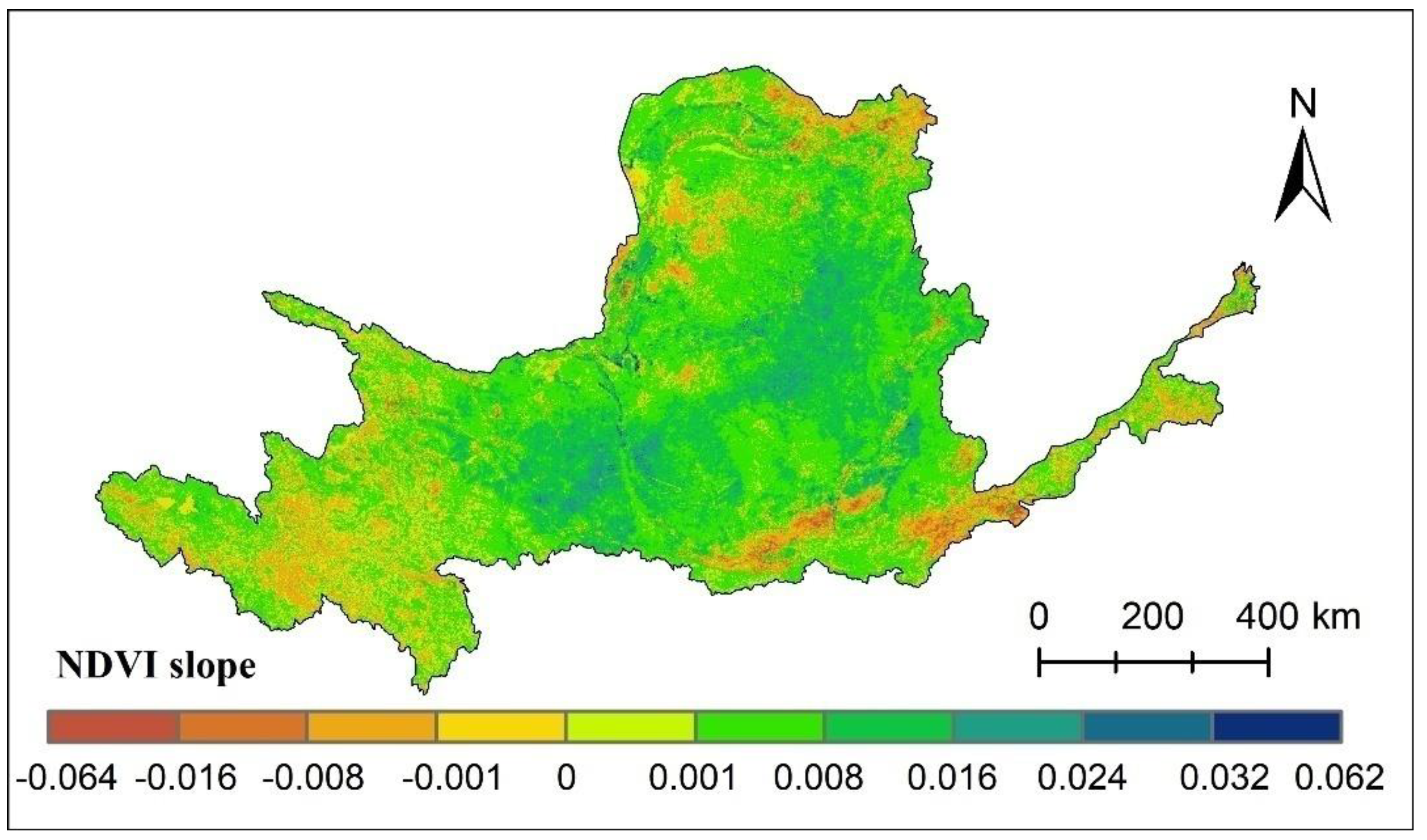
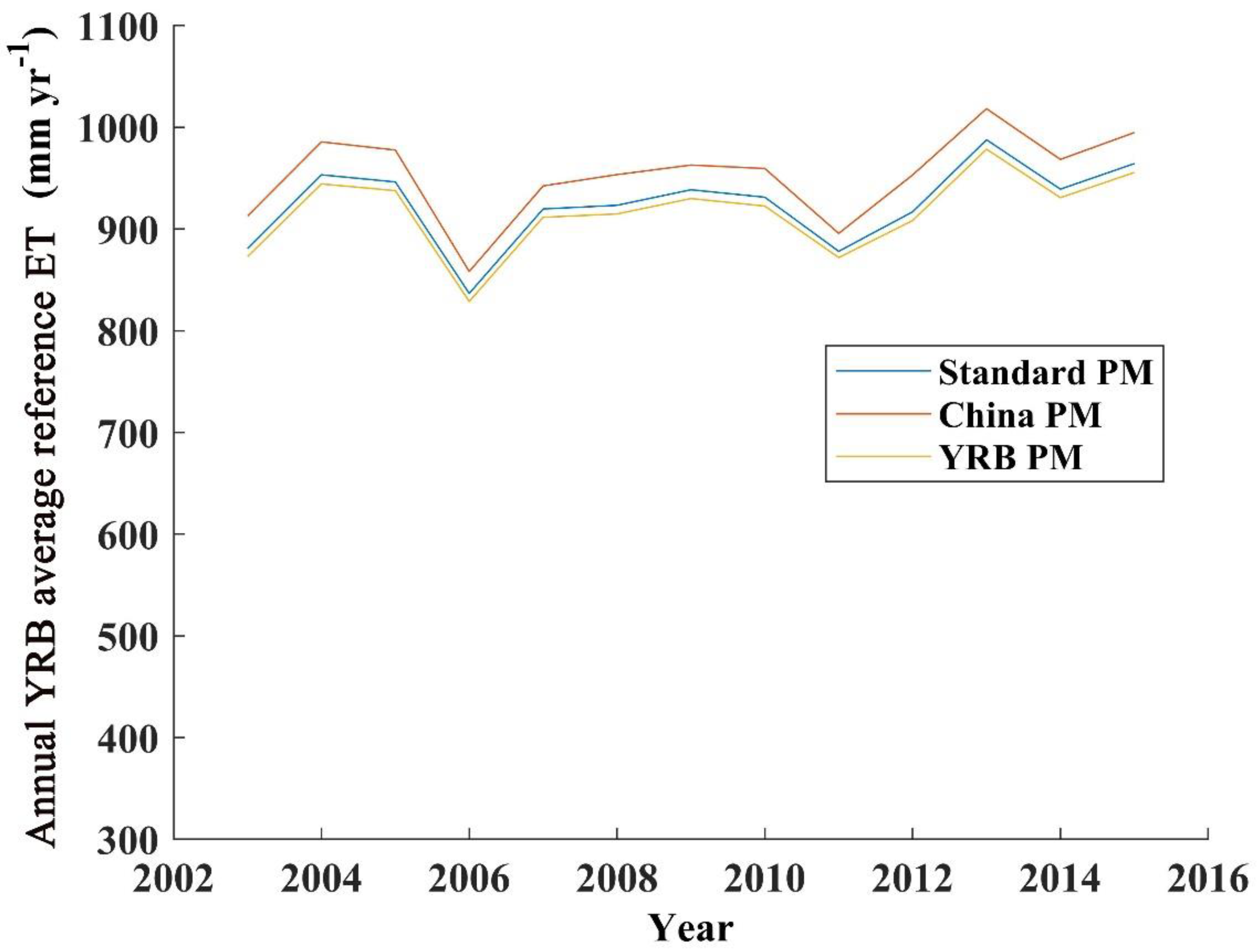

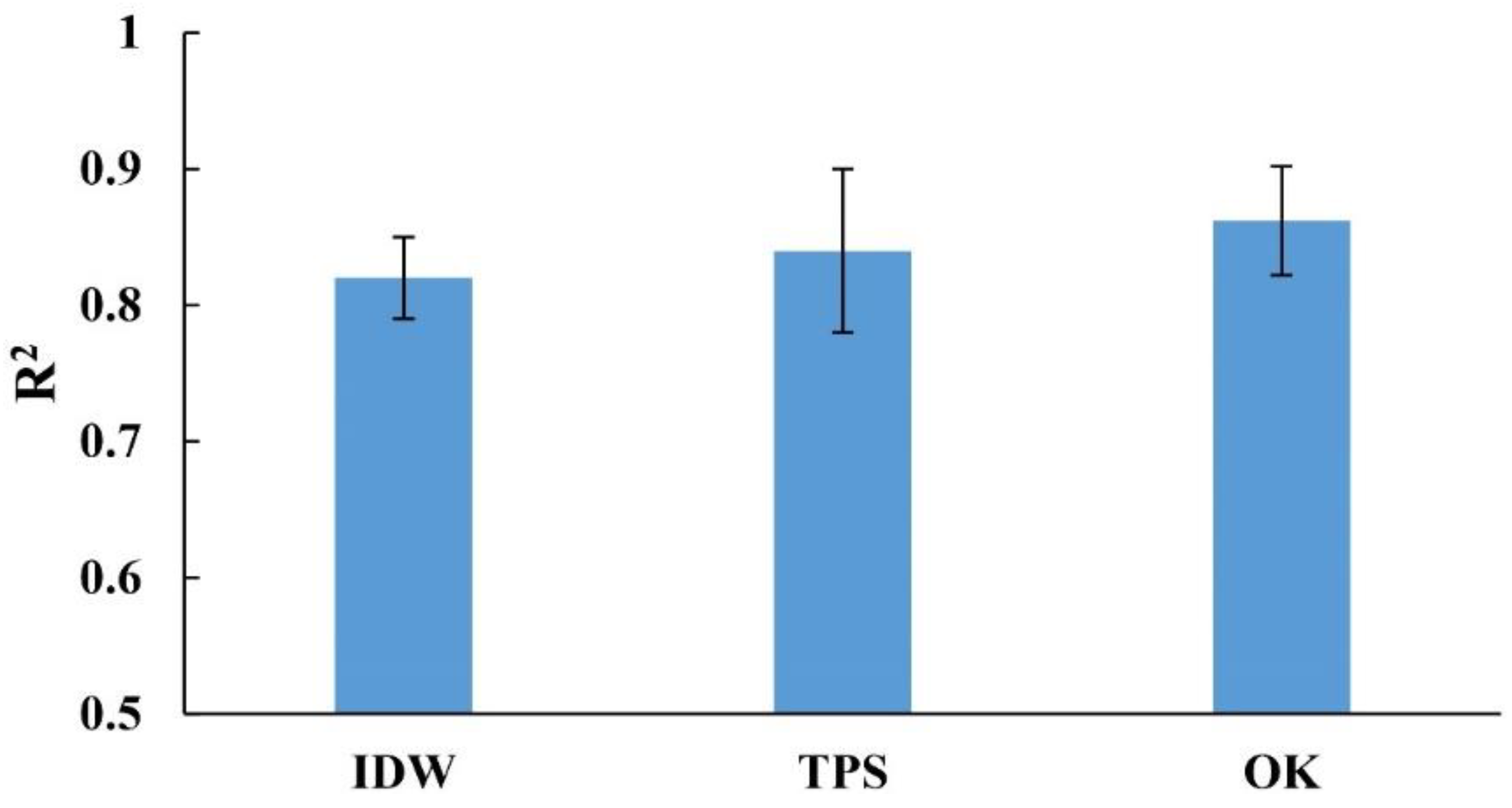

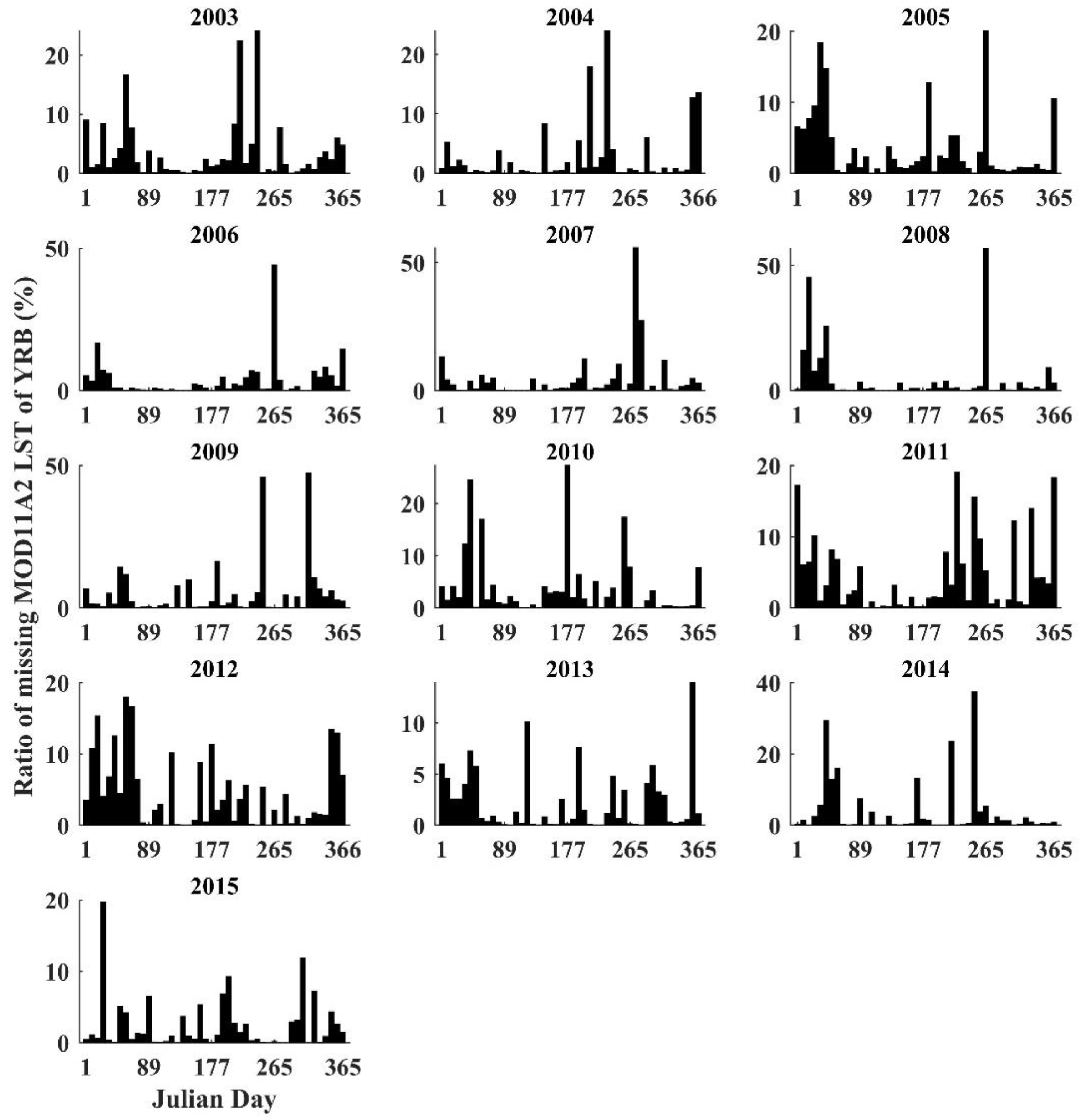
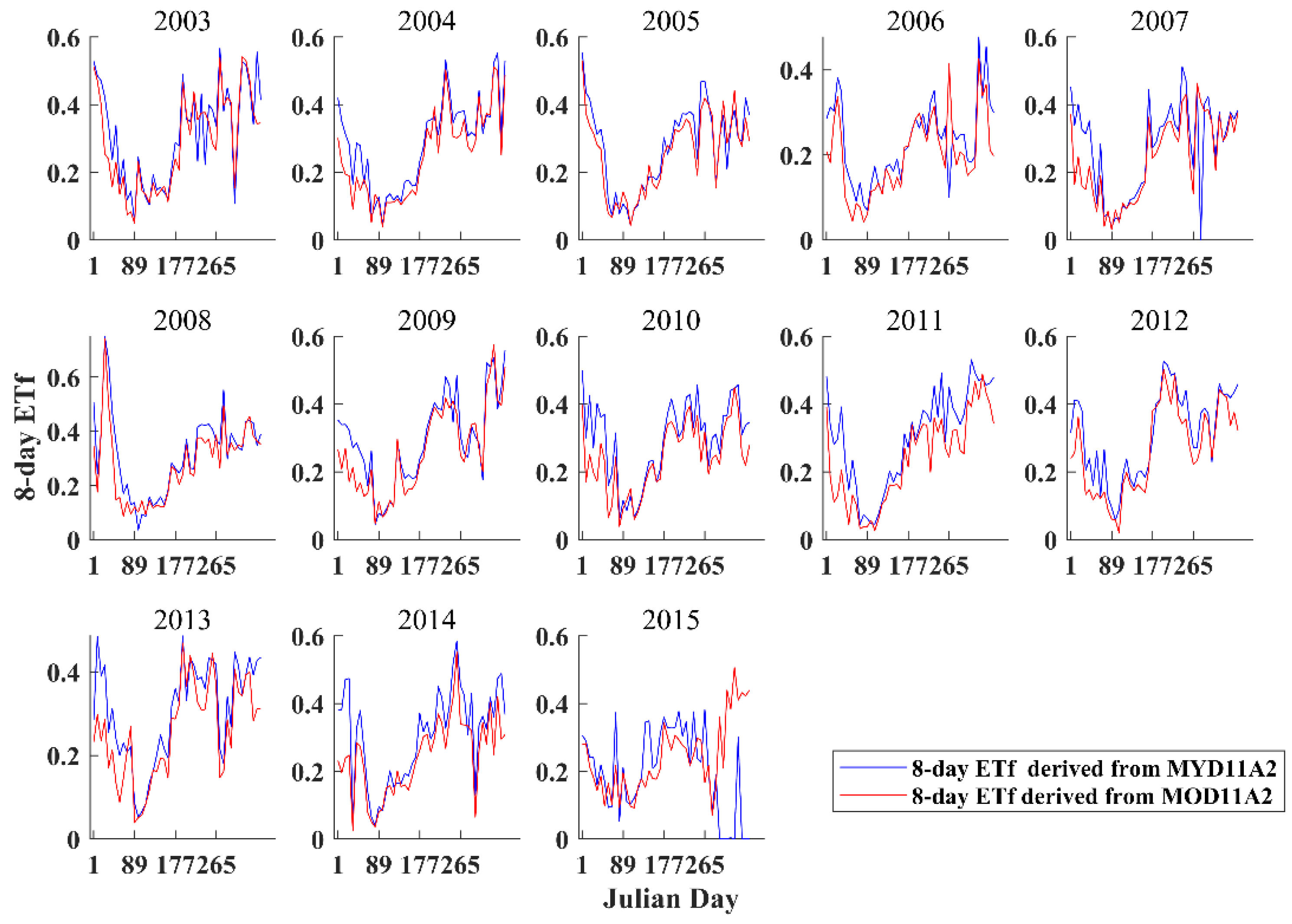
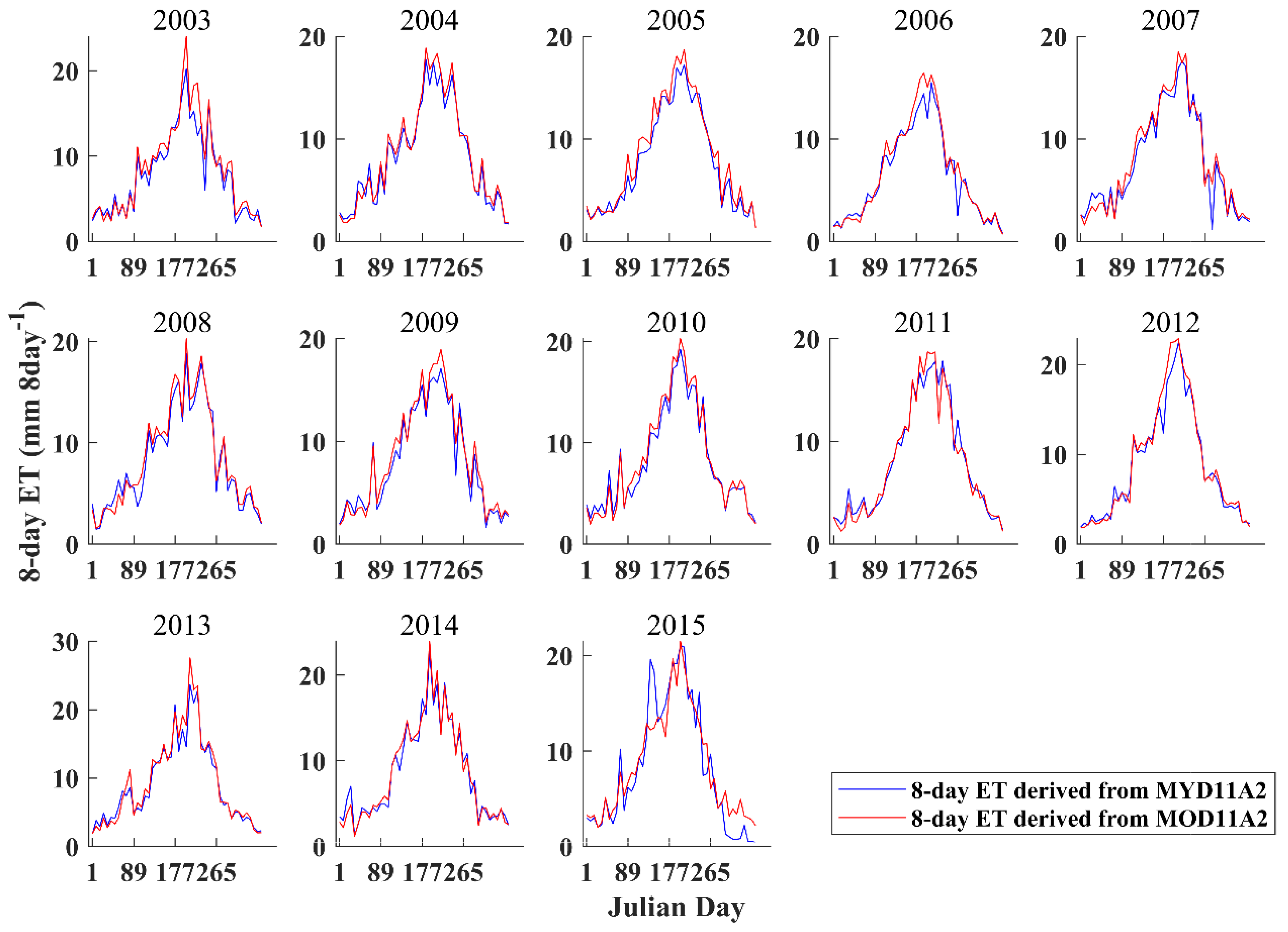
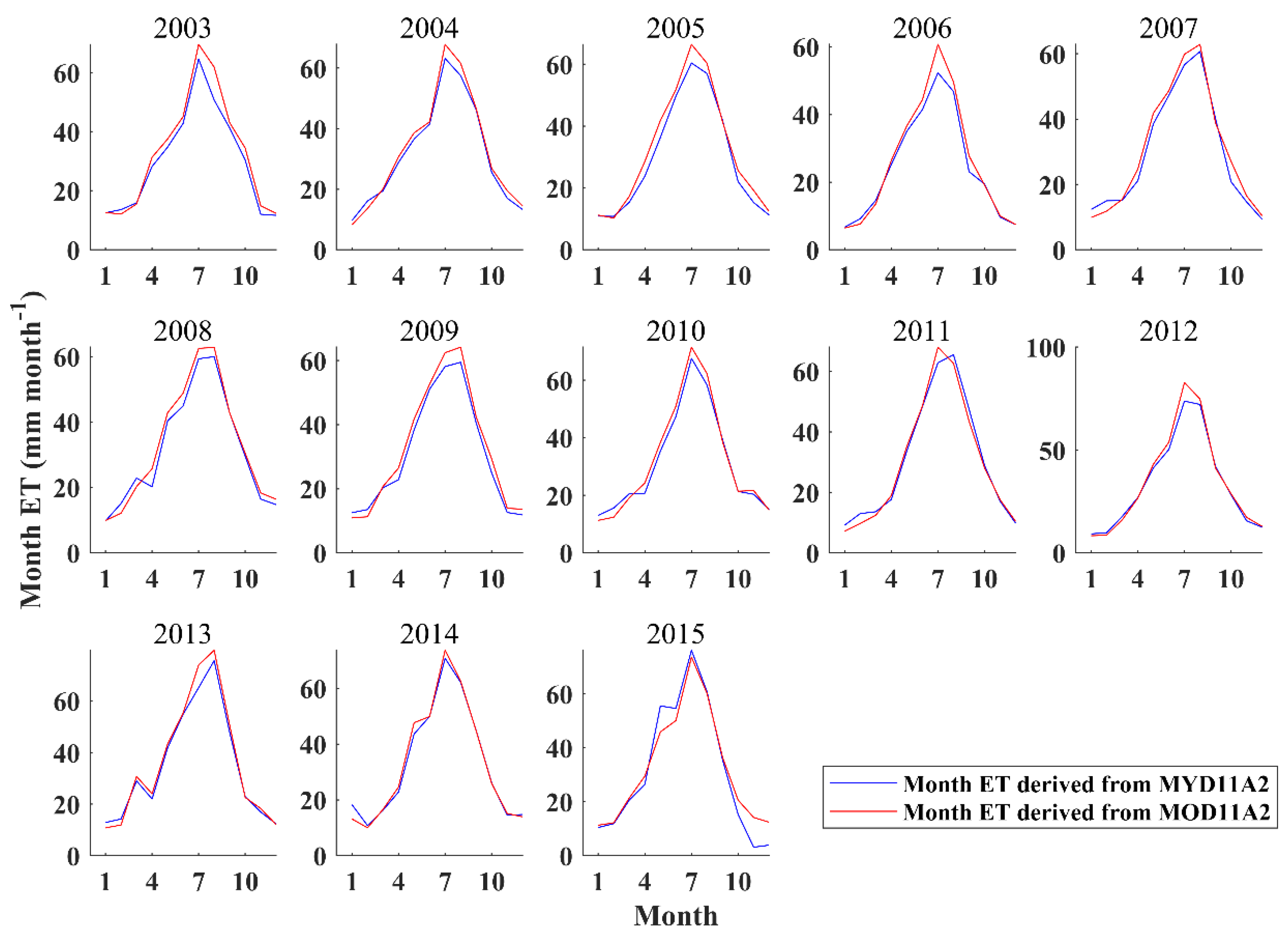

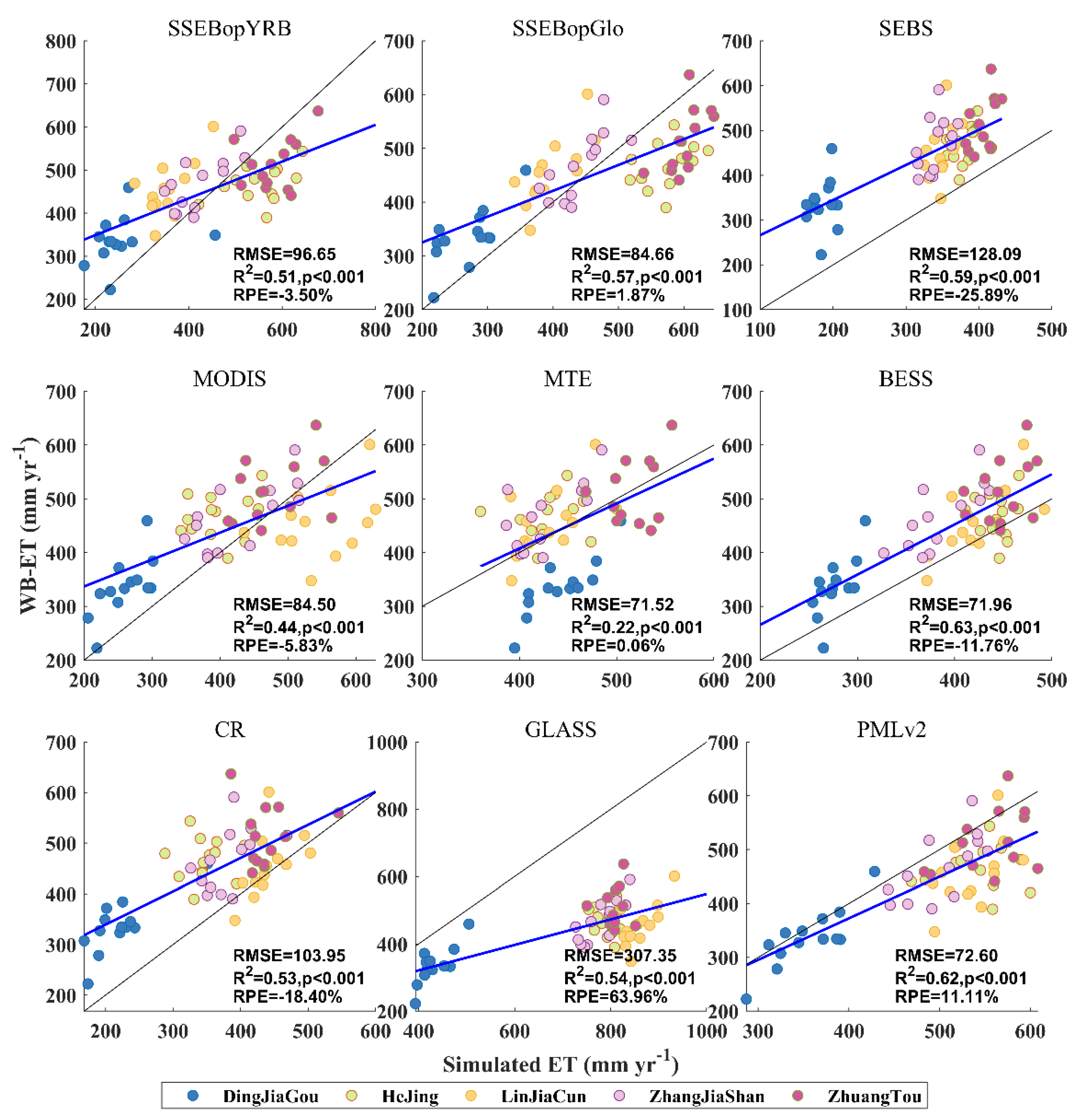
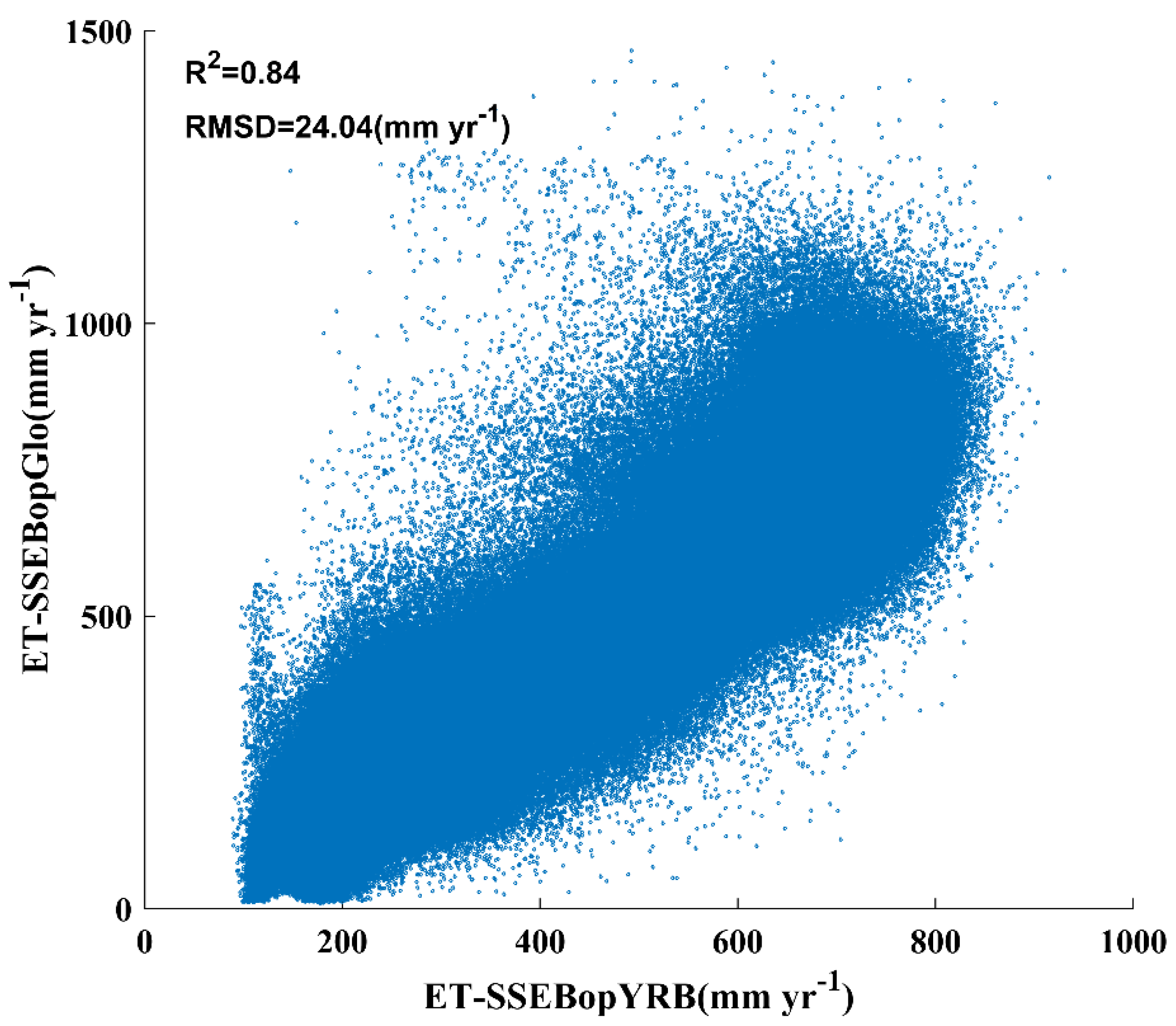
References
- Baldocchi, D.; Dralle, D.; Jiang, C.; Ryu, Y. How Much Water Is Evaporated Across California? A Multiyear Assessment Using a Biophysical Model Forced with Satellite Remote Sensing Data. Water Resour. Res. 2019, 55, 2722–2741. [Google Scholar] [CrossRef]
- Feng, X.; Fu, B.; Piao, S.; Wang, S.; Ciais, P.; Zeng, Z.; Lü, Y.-H.; Zeng, Y.; Li, Y.; Jiang, X.; et al. Revegetation in China’s Loess Plateau is approaching sustainable water resource limits. Nat. Clim. Chang. 2016, 6, 1019–1022. [Google Scholar] [CrossRef]
- Zhang, M.; Wang, S.; Fu, B.; Gao, G.; Shen, Q. Ecological effects and potential risks of the water diversion project in the Heihe River Basin. Sci. Total. Environ. 2018, 619, 794–803. [Google Scholar] [CrossRef] [PubMed]
- Feng, X.M.; Liu, Q.L.; Yin, L.C.; Fu, B.J.; Chen, Y.Z. Linking water research with the sustainability of the human-natural system. Curr. Opin. Environ. Sustain. 2018, 33, 99–103. [Google Scholar]
- Sun, G.; Alstad, K.; Chen, J.; Chen, S.; Ford, C.R.; Lin, G.; Liu, C.; Lu, N.; McNulty, S.G.; Miao, H.; et al. A general predictive model for estimating monthly ecosystem evapotranspiration. Ecohydrology 2010, 4, 245–255. [Google Scholar] [CrossRef]
- Ryu, Y.; Baldocchi, D.; Kobayashi, H.; Van Ingen, C.; Li, J.; Black, T.A.; Beringer, J.; Van Gorsel, E.; Knohl, A.; Law, B.; et al. Integration of MODIS land and atmosphere products with a coupled-process model to estimate gross primary productivity and evapotranspiration from 1 km to global scales. Glob. Biogeochem. Cycles 2011, 25, 25. [Google Scholar] [CrossRef] [Green Version]
- Hu, Z.; Li, S.; Yu, G.-R.; Sun, X.; Zhang, L.; Han, S.; Li, Y. Modeling evapotranspiration by combing a two-source model, a leaf stomatal model, and a light-use efficiency model. J. Hydrol. 2013, 501, 186–192. [Google Scholar] [CrossRef]
- Senay, G.B.; Bohms, S.; Singh, R.; Gowda, P.H.; Velpuri, M.; Alemu, H.; Verdin, J.P. Operational Evapotranspiration Mapping Using Remote Sensing and Weather Datasets: A New Parameterization for the SSEB Approach. JAWRA J. Am. Water Resour. Assoc. 2013, 49, 577–591. [Google Scholar] [CrossRef] [Green Version]
- Liu, Z.; Yao, Z.; Wang, R. Simulation and evaluation of actual evapotranspiration based on inverse hydrological modeling at a basin scale. Catena 2019, 180, 160–168. [Google Scholar] [CrossRef]
- Palmroth, S.; Katul, G.; Hui, D.; McCarthy, H.R.; Jackson, R.B.; Oren, R. Estimation of long-term basin scale evapotranspiration from streamflow time series. Water Resour. Res. 2010, 46, 46. [Google Scholar] [CrossRef] [Green Version]
- Wang, K.; Wang, P.; Li, Z.; Cribb, M.; Sparrow, M. A simple method to estimate actual evapotranspiration from a combination of net radiation, vegetation index, and temperature. J. Geophys. Res. Space Phys. 2007, 112, 112. [Google Scholar] [CrossRef]
- Jung, M.; Reichstein, M.; Ciais, P.; Seneviratne, S.I.; Sheffield, J.; Goulden, M.L.; Bonan, G.; Cescatti, A.; Chen, J.; De Jeu, R.; et al. Recent decline in the global land evapotranspiration trend due to limited moisture supply. Nature 2010, 467, 951–954. [Google Scholar] [CrossRef]
- Bhattarai, N.; Mallick, K.; Stuart, J.; Vishwakarma, B.D.; Niraula, R.; Sen, S.; Jain, M. An automated multi-model evapotranspiration mapping framework using remotely sensed and reanalysis data. Remote Sens. Environ. 2019, 229, 69–92. [Google Scholar] [CrossRef]
- Roerink, G.; Su, Z.; Menenti, M. S-SEBI: A simple remote sensing algorithm to estimate the surface energy balance. Phys. Chem. Earth Part B Hydrol. Oceans Atmos. 2000, 25, 147–157. [Google Scholar] [CrossRef]
- Yang, Y.; Shang, S.; Jiang, L. Remote sensing temporal and spatial patterns of evapotranspiration and the responses to water management in a large irrigation district of North China. Agric. For. Meteorol. 2012, 164, 112–122. [Google Scholar] [CrossRef]
- Chen, X.; Su, Z.; Ma, Y.; Liu, S.; Yu, Q.; Xu, Z. Development of a 10-year (2001–2010) 0.1° data set of land-surface energy balance for mainland China. Atmos. Chem. Phys. Discuss. 2014, 14, 13097–13117. [Google Scholar] [CrossRef] [Green Version]
- Senay, G.B. Satellite Psychrometric Formulation of the Operational Simplified Surface Energy Balance (SSEBop) Model for Quantifying and Mapping Evapotranspiration. Appl. Eng. Agric. 2018, 34, 555–566. [Google Scholar] [CrossRef] [Green Version]
- Lopes, J.D.; Rodrigues, L.N.; Imbuzeiro, H.M.A.; Pruski, F.F. Performance of SSEBop model for estimating wheat actual evapotranspiration in the Brazilian Savannah region. Int. J. Remote Sens. 2019, 40, 6930–6947. [Google Scholar] [CrossRef]
- De Paula, A.C.P.; De Figueiredo, C.C.; Rodrigues, L.N.; Warren, M.S. Performance of the SSEBop model in the estimation of the actual evapotranspiration of soybean and bean crops. Pesquisa Agropecuária Brasileira 2019, 54, 54. [Google Scholar] [CrossRef]
- Wagle, P.; Bhattarai, N.; Gowda, P.H.; Zhou, Y. Performance of five surface energy balance models for estimating daily evapotranspiration in high biomass sorghum. ISPRS J. Photogramm. Remote Sens. 2017, 128, 192–203. [Google Scholar] [CrossRef] [Green Version]
- Velpuri, N.M.; Senay, G.B. Partitioning Evapotranspiration into Green and Blue Water Sources in the Conterminous United States. Sci. Rep. 2017, 7, 6191. [Google Scholar] [CrossRef] [PubMed]
- Bhattarai, N.; Wagle, P.; Gowda, P.H.; Zhou, Y. Utility of remote sensing-based surface energy balance models to track water stress in rain-fed switchgrass under dry and wet conditions. ISPRS J. Photogramm. Remote Sens. 2017, 133, 128–141. [Google Scholar] [CrossRef]
- Senay, G.B.; Schauer, M.; Friedrichs, M.; Velpuri, N.M.; Singh, R.K. Satellite-based water use dynamics using historical Landsat data (1984–2014) in the southwestern United States. Remote Sens. Environ. 2017, 202, 98–112. [Google Scholar] [CrossRef]
- Singh, R.; Senay, G.B. Comparison of Four Different Energy Balance Models for Estimating Evapotranspiration in the Midwestern United States. Water 2015, 8, 9. [Google Scholar] [CrossRef] [Green Version]
- Singh, R.; Senay, G.B.; Velpuri, N.M.; Bohms, S.; Scott, R.L.; Verdin, J.P. Actual Evapotranspiration (Water Use) Assessment of the Colorado River Basin at the Landsat Resolution Using the Operational Simplified Surface Energy Balance Model. Remote Sens. 2013, 6, 233–256. [Google Scholar] [CrossRef] [Green Version]
- Alemu, H.; Senay, G.B.; Kaptué, A.T.; Kovalskyy, V. Evapotranspiration Variability and Its Association with Vegetation Dynamics in the Nile Basin, 2002–2011. Remote Sens. 2014, 6, 5885–5908. [Google Scholar] [CrossRef] [Green Version]
- Alemu, H.; Kaptué, A.T.; Senay, G.B.; Wimberly, M.C.; Henebry, G. Evapotranspiration in the Nile Basin: Identifying Dynamics and Drivers, 2002–2011. Water 2015, 7, 4914–4931. [Google Scholar] [CrossRef]
- Alemayehu, T.; Van Griensven, A.; Senay, G.B.; Bauwens, W. Evapotranspiration Mapping in a Heterogeneous Landscape Using Remote Sensing and Global Weather Datasets: Application to the Mara Basin, East Africa. Remote Sens. 2017, 9, 390. [Google Scholar] [CrossRef] [Green Version]
- Olivera-Guerra, L.; Mattar, C.; Merlin, O.; Durán-Alarcón, C.; Artigas, A.S.-; Fuster, R. An operational method for the disaggregation of land surface temperature to estimate actual evapotranspiration in the arid region of Chile. ISPRS J. Photogramm. Remote Sens. 2017, 128, 170–181. [Google Scholar] [CrossRef] [Green Version]
- Tadesse, T.; Senay, G.B.; Berhan, G.; Regassa, T.; Beyene, S. Evaluating a satellite-based seasonal evapotranspiration product and identifying its relationship with other satellite-derived products and crop yield: A case study for Ethiopia. Int. J. Appl. Earth Obs. Geoinform. 2015, 40, 39–54. [Google Scholar] [CrossRef] [Green Version]
- Velpuri, N.M.; Senay, G.; Singh, R.K.; Bohms, S.; Verdin, J. A comprehensive evaluation of two MODIS evapotranspiration products over the conterminous United States: Using point and gridded FLUXNET and water balance ET. Remote Sens. Environ. 2013, 139, 35–49. [Google Scholar] [CrossRef]
- Chen, M.; Senay, G.B.; Singh, R.K.; Verdin, J.P. Uncertainty analysis of the Operational Simplified Surface Energy Balance (SSEBop) model at multiple flux tower sites. J. Hydrol. 2016, 536, 384–399. [Google Scholar] [CrossRef] [Green Version]
- Bhattarai, N.; Shaw, S.B.; Quackenbush, L.; Im, J.; Niraula, R. Evaluating five remote sensing based single-source surface energy balance models for estimating daily evapotranspiration in a humid subtropical climate. Int. J. Appl. Earth Obs. Geoinform. 2016, 49, 75–86. [Google Scholar] [CrossRef]
- Li, X.; He, Y.; Zeng, Z.; Lian, X.; Wang, X.; Du, M.; Jia, G.; Li, Y.; Ma, Y.; Tang, Y.; et al. Spatiotemporal pattern of terrestrial evapotranspiration in China during the past thirty years. Agric. For. Meteorol. 2018, 259, 131–140. [Google Scholar] [CrossRef]
- Mueller, B.; Hirschi, M.; Jiménez, C.; Ciais, P.; Dirmeyer, P.A.; Dolman, H.; Fisher, J.; Jung, M.; Ludwig, F.; Maignan, F.; et al. Benchmark products for land evapotranspiration: LandFlux-EVAL multi-data set synthesis. Hydrol. Earth Syst. Sci. 2013, 17, 3707–3720. [Google Scholar] [CrossRef] [Green Version]
- Jasechko, S.; Sharp, Z.D.; Gibson, J.J.; Birks, S.J.; Yi, Y.; Fawcett, P.J. Terrestrial water fluxes dominated by transpiration. Nature 2013, 496, 347–350. [Google Scholar] [CrossRef]
- Xiong, Y.; Zhao, W.L.; Wang, P.; Paw U, K.T.; Qiu, G.Y. Simple and Applicable Method for Estimating Evapotranspiration and Its Components in Arid Regions. J. Geophys. Res. Atmos. 2019, 124, 9963–9982. [Google Scholar] [CrossRef]
- Bai, M.; Mo, X.; Liu, S.; Hu, S. Contributions of climate change and vegetation greening to evapotranspiration trend in a typical hilly-gully basin on the Loess Plateau, China. Sci. Total Environ. 2019, 657, 325–339. [Google Scholar] [CrossRef]
- Feng, X.M.; Sun, G.; Fu, B.J.; Su, C.H.; Liu, Y.; Lamparski, H. Regional effects of vegetation restoration on water yield across the Loess Plateau, China. Hydrol. Earth Syst. Sci. 2012, 16, 2617–2628. [Google Scholar] [CrossRef] [Green Version]
- Xu, S.; Yu, Z.; Yang, C.; Ji, X.; Zhang, K. Trends in evapotranspiration and their responses to climate change and vegetation greening over the upper reaches of the Yellow River Basin. Agric. For. Meteorol. 2018, 263, 118–129. [Google Scholar] [CrossRef]
- Yuan, X.; Bai, J. Future Projected Changes in Local Evapotranspiration Coupled with Temperature and Precipitation Variation. Sustainability 2018, 10, 3281. [Google Scholar] [CrossRef] [Green Version]
- Fu, B.; Wang, S.; Liu, Y.; Liu, J.; Liang, W.; Miao, C. Hydrogeomorphic Ecosystem Responses to Natural and Anthropogenic Changes in the Loess Plateau of China. Annu. Rev. Earth Planet. Sci. 2017, 45, 223–243. [Google Scholar] [CrossRef]
- Fu, B.; Liu, Y.; Lü, Y.; He, C.; Zeng, Y.; Wu, B. Assessing the soil erosion control service of ecosystems change in the Loess Plateau of China. Ecol. Complex. 2011, 8, 284–293. [Google Scholar] [CrossRef]
- Lü, Y.; Fu, B.; Feng, X.; Zeng, Y.; Liu, Y.; Chang, R.; Sun, G.; Wu, B. A Policy-Driven Large Scale Ecological Restoration: Quantifying Ecosystem Services Changes in the Loess Plateau of China. PLoS ONE 2012, 7, e31782. [Google Scholar] [CrossRef] [PubMed]
- Zhengxing, W.; Linghong, K.E.; Fangping, D. Doubling MODIS-NDVI Temporal Resolution: From 16-Day to 8-Day. Remote Sens. Technol. Appl. 2011, 26, 437–443. [Google Scholar]
- Pede, T.; Mountrakis, G. An empirical comparison of interpolation methods for MODIS 8-day land surface temperature composites across the conterminous Unites States. ISPRS J. Photogramm. Remote Sens. 2018, 142, 137–150. [Google Scholar] [CrossRef]
- Carter, C.; Liang, S. Comprehensive evaluation of empirical algorithms for estimating land surface evapotranspiration. Agric. For. Meteorol. 2018, 2018, 334–345. [Google Scholar] [CrossRef] [Green Version]
- McVicar, T.R.; Van Niel, T.; Li, L.; Hutchinson, M.F.; Mu, X.; Liu, Z. Spatially distributing monthly reference evapotranspiration and pan evaporation considering topographic influences. J. Hydrol. 2007, 338, 196–220. [Google Scholar] [CrossRef]
- Wahba, G.; Wendelberger, J.G. Some New Mathematical Methods for Variational Objective Analysis Using Splines and Cross Validation. Mon. Weather. Rev. 1980, 108, 1122–1143. [Google Scholar] [CrossRef] [Green Version]
- Allen, R.G.; Pereira, L.S.; Raes, D.; Smith, M. Crop Evapotranspiration—Guidelines for Computing Crop Water Requirements-FAO Irrigation and drainage paper 56 1998. Available online: http://http://www.fao.org/3/X0490E/x0490e05.htm (accessed on 5 August 2020).
- Ma, N.; Szilagyi, J.; Zhang, Y.; Liu, W. Complementary-Relationship-Based Modeling of Terrestrial Evapotranspiration across China during 1982–2012: Validations and Spatiotemporal Analyses. J. Geophys. Res. Atmos. 2019, 124, 4326–4351. [Google Scholar] [CrossRef]
- Monteith, J.L. Evaporation and environment. Symp. Soc. Exp. Boil. 1965, 19, 205–234. [Google Scholar]
- Peng, S.; Piao, S.; Zeng, Z.; Ciais, P.; Zhou, L.; Li, L.; Myneni, R.; Yin, Y.; Zeng, H. Afforestation in China cools local land surface temperature. Proc. Natl. Acad. Sci. USA 2014, 111, 2915–2919. [Google Scholar] [CrossRef] [PubMed] [Green Version]
- Tang, R.; Shao, K.; Li, Z.-L.; Wu, H.; Tang, B.-H.; Zhou, G.; Zhang, L. Multiscale Validation of the 8-day MOD16 Evapotranspiration Product Using Flux Data Collected in China. IEEE J. Sel. Top. Appl. Earth Obs. Remote Sens. 2015, 8, 1478–1486. [Google Scholar] [CrossRef]
- Jiang, C.; Ryu, Y. Multi-scale evaluation of global gross primary productivity and evapotranspiration products derived from Breathing Earth System Simulator (BESS). Remote Sens. Environ. 2016, 186, 528–547. [Google Scholar] [CrossRef]
- Leuning, R.; Zhang, Y.; Rajaud, A.; Cleugh, H.; Tu, K. A simple surface conductance model to estimate regional evaporation using MODIS leaf area index and the Penman-Monteith equation. Water Resour. Res. 2008, 44, 44. [Google Scholar] [CrossRef]
- Zhang, Y.; Leuning, R.; Hutley, L.; Beringer, J.; McHugh, I.; Walker, J.P. Using long-term water balances to parameterize surface conductances and calculate evaporation at 0.05° spatial resolution. Water Resour. Res. 2010, 46, 242–253. [Google Scholar] [CrossRef] [Green Version]
- Gan, R.; Zhang, Y.; Shi, H.; Yang, Y.; Eamus, D.; Cheng, L.; Chiew, F.H.; Yu, Q. Use of satellite leaf area index estimating evapotranspiration and gross assimilation for Australian ecosystems. Ecohydrology 2018, 11, e1974. [Google Scholar] [CrossRef]
- Zhang, Y.Q.; Kong, D.D.; Gan, R.; Chiew, F.H.S.; McVicar, T.R.; Zhang, Q.; Yang, Y.T. Coupled estimation of 500 m and 8-day resolution global evapotranspiration and gross primary production in 2002–2017. Remote Sens. Environ. 2019, 222, 165–182. [Google Scholar] [CrossRef]
- Chen, X.; Massman, W.J.; Su, Z. A Column Canopy-Air Turbulent Diffusion Method for Different Canopy Structures. J. Geophys. Res. Atmos. 2019, 124, 488–506. [Google Scholar] [CrossRef]
- Yuan, W.; Liu, S.; Yu, G.; Bonnefond, J.-M.; Chen, J.; Davis, K.; Desai, A.R.; Goldstein, A.H.; Gianelle, D.; Rossi, F.; et al. Global estimates of evapotranspiration and gross primary production based on MODIS and global meteorology data. Remote Sens. Environ. 2010, 114, 1416–1431. [Google Scholar] [CrossRef] [Green Version]
- Fisher, J.; Tu, K.P.; Baldocchi, D. Global estimates of the land–atmosphere water flux based on monthly AVHRR and ISLSCP-II data, validated at 16 FLUXNET sites. Remote Sens. Environ. 2008, 112, 901–919. [Google Scholar] [CrossRef]
- Yao, Y.; Liang, S.; Cheng, J.; Liu, S.; Fisher, J.B.; Zhang, X.; Jia, K.; Zhao, X.; Qin, Q.; Zhao, B.; et al. MODIS-driven estimation of terrestrial latent heat flux in China based on a modified Priestley–Taylor algorithm. Agric. For. Meteorol. 2013, 171, 187–202. [Google Scholar] [CrossRef]
- Wang, K.; Dickinson, R.E.; Wild, M.; Liang, S. Evidence for decadal variation in global terrestrial evapotranspiration between 1982 and 2002: 2. Results. J. Geophys. Res. Space Phys. 2010, 115, 115. [Google Scholar] [CrossRef] [Green Version]
- Yao, Y.; Liang, S.; Li, X.; Hong, Y.; Fisher, J.; Zhang, N.; Chen, J.; Cheng, J.; Zhao, S.; Zhang, X.; et al. Bayesian multimodel estimation of global terrestrial latent heat flux from eddy covariance, meteorological, and satellite observations. J. Geophys. Res. Atmos. 2014, 119, 4521–4545. [Google Scholar] [CrossRef]
- Zhang, Y.; Feng, X.; Wang, X.; Fu, B. Characterizing drought in terms of changes in the precipitation–runoff relationship: A case study of the Loess Plateau, China. Hydrol. Earth Syst. Sci. 2018, 22, 1749–1766. [Google Scholar] [CrossRef] [Green Version]
- Huffman, G.J.; Bolvin, D.T.; Nelkin, E.J.; Wolff, D.B.; Adler, R.F.; Gu, G.; Hong, Y.; Bowman, K.P.; Stocker, E.F. The TRMM Multisatellite Precipitation Analysis (TMPA): Quasi-Global, Multiyear, Combined-Sensor Precipitation Estimates at Fine Scales. J. Hydrometeorol. 2007, 8, 38–55. [Google Scholar] [CrossRef]
- Harris, I.; Jones, P.; Osborn, T.J.; Lister, D.H. Updated high-resolution grids of monthly climatic observations-the CRU TS3.10 Dataset. Int. J. Clim. 2013, 34, 623–642. [Google Scholar] [CrossRef] [Green Version]
- He, J.; Yang, K.; Tang, W.; Lu, H.; Qin, J.; Chen, Y.; Li, X. The first high-resolution meteorological forcing dataset for land process studies over China. Sci. Data 2020, 7, 1–11. [Google Scholar] [CrossRef] [Green Version]
- Wang, W.; Shao, Q.; Peng, S.; Xing, W.; Yang, T.; Luo, Y.; Gourley, J.J.; Xu, J. Reference evapotranspiration change and the causes across the Yellow River Basin during 1957-2008 and their spatial and seasonal differences. Water Resour. Res. 2012, 48, 48. [Google Scholar] [CrossRef]
- MathWorks, Statistics and Machine Learning Toolbox™ User’s Guide. 2019. Available online: https://kr.mathworks.com/ (accessed on 5 August 2020).
- Yin, L.C.; Feng, X.M.; Fu, B.J.; Chen, Y.Z.; Wang, X.F.; Tao, F.L. Irrigation water consumption of irrigated cropland and its dominant factor in China from 1982 to 2015. Adv. Water Resour. 2020, 143, 103661. [Google Scholar] [CrossRef]
- Arowolo, A.O.; Bhowmik, A.K.; Qi, W.; Deng, X. Comparison of spatial interpolation techniques to generate high-resolution climate surfaces for Nigeria. Int. J. Clim. 2017, 37, 179–192. [Google Scholar] [CrossRef]
- Yin, Y.; Wu, S.; Zheng, D.; Yang, Q. Radiation calibration of FAO56 Penman–Monteith model to estimate reference crop evapotranspiration in China. Agric. Water Manag. 2008, 95, 77–84. [Google Scholar] [CrossRef]
- Hulley, G.C.; Hughes, C.G.; Hook, S.J. Quantifying uncertainties in land surface temperature and emissivity retrievals from ASTER and MODIS thermal infrared data. J. Geophys. Res. Space Phys. 2012, 117, 117. [Google Scholar] [CrossRef] [Green Version]
- Yu, W.; Ma, M.; Yang, H.; Tan, J.; Li, X. Supplement of the radiance-based method to validate satellite-derived land surface temperature products over heterogeneous land surfaces. Remote Sens. Environ. 2019, 230, 111188. [Google Scholar] [CrossRef]
- Militino, A.F.; Ugarte, M.D.; Pérez-Goya, U.; Genton, M.G. Interpolation of the Mean Anomalies for Cloud Filling in Land Surface Temperature and Normalized Difference Vegetation Index. IEEE Trans. Geosci. Remote Sens. 2019, 57, 6068–6078. [Google Scholar] [CrossRef]
- Swenson, W.A.; Shuter, B.J.; Orr, D.J.; Heberling, G.D. The effects of stream temperature and velocity on first-year growth and year-class abundance of smallmouth bass in the Upper Mississippi River. Black Bass Ecol. Conserv. Manag. 2002, 31, 101–113. [Google Scholar]
- Jin, Z.; Liang, W.; Yang, Y.; Zhang, W.; Yan, J.; Chen, X.; Li, S.; Mo, X. Separating Vegetation Greening and Climate Change Controls on Evapotranspiration trend over the Loess Plateau. Sci. Rep. 2017, 7, 1–15. [Google Scholar] [CrossRef]
- Kun, Y. China Meteorological Forcing Dataset (1979–2018); National Tibetan Plateau Data Center, Ed.; National Tibetan Plateau Data Center: Beijing, China, 2018. [Google Scholar]
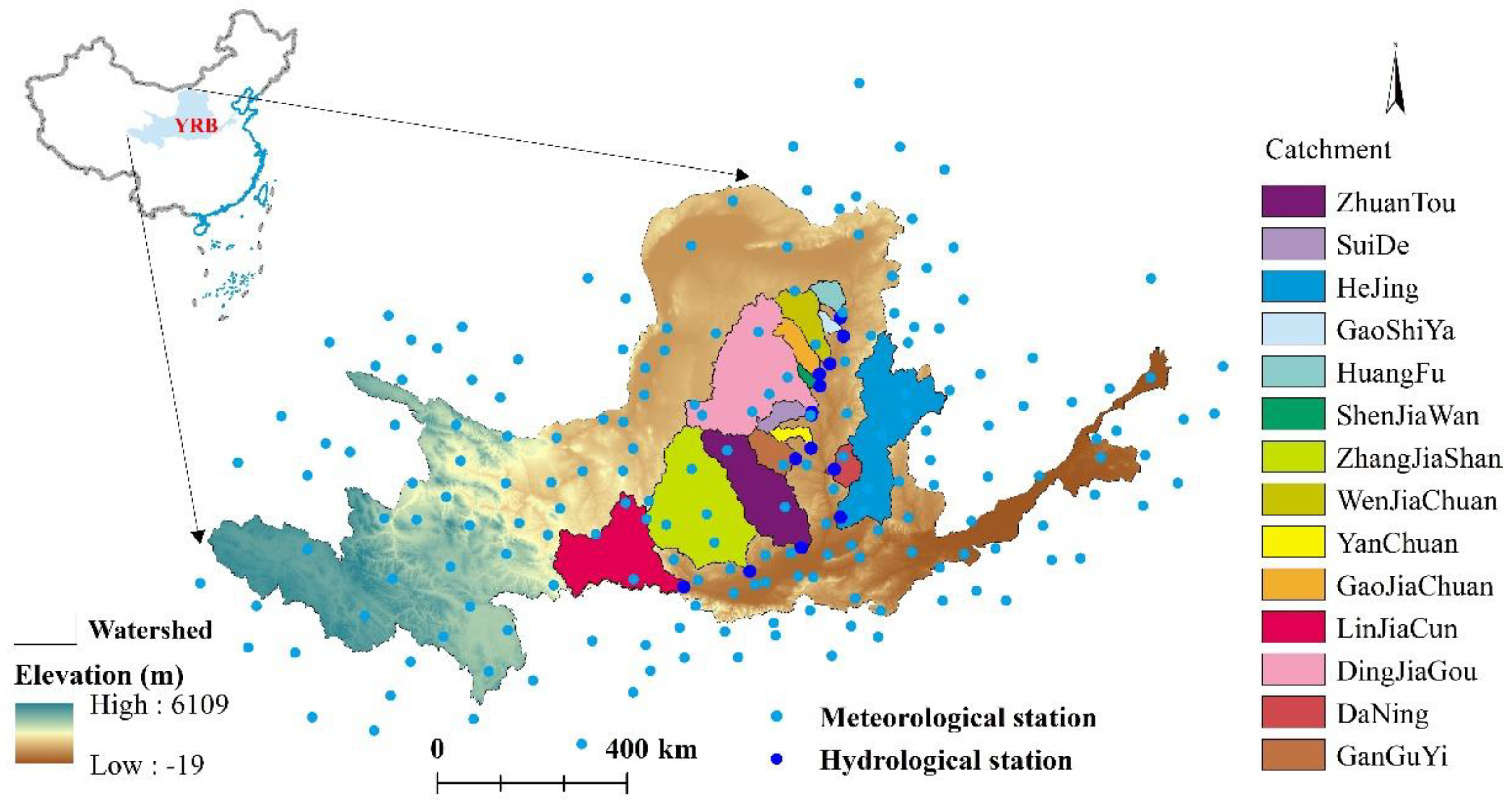
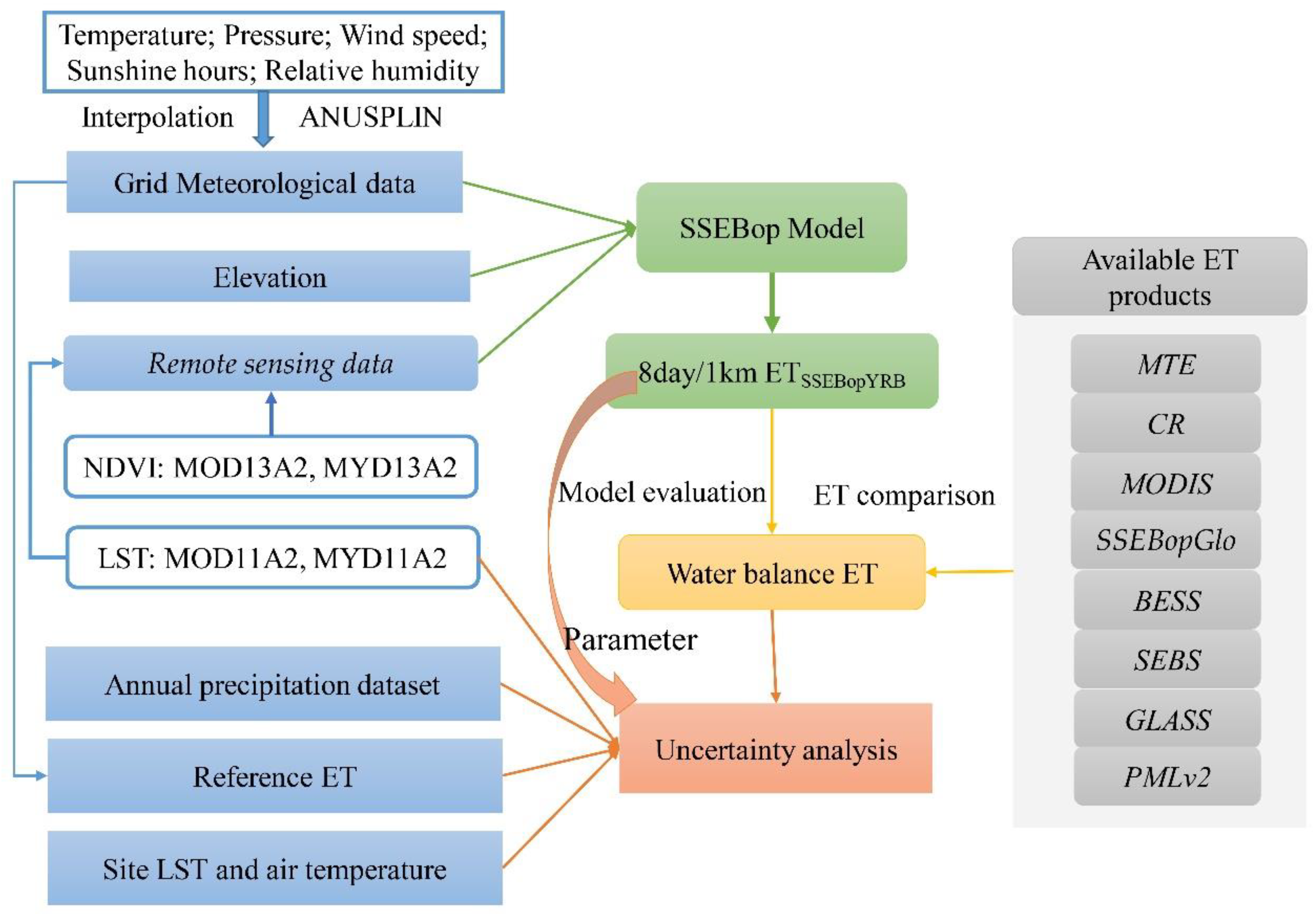

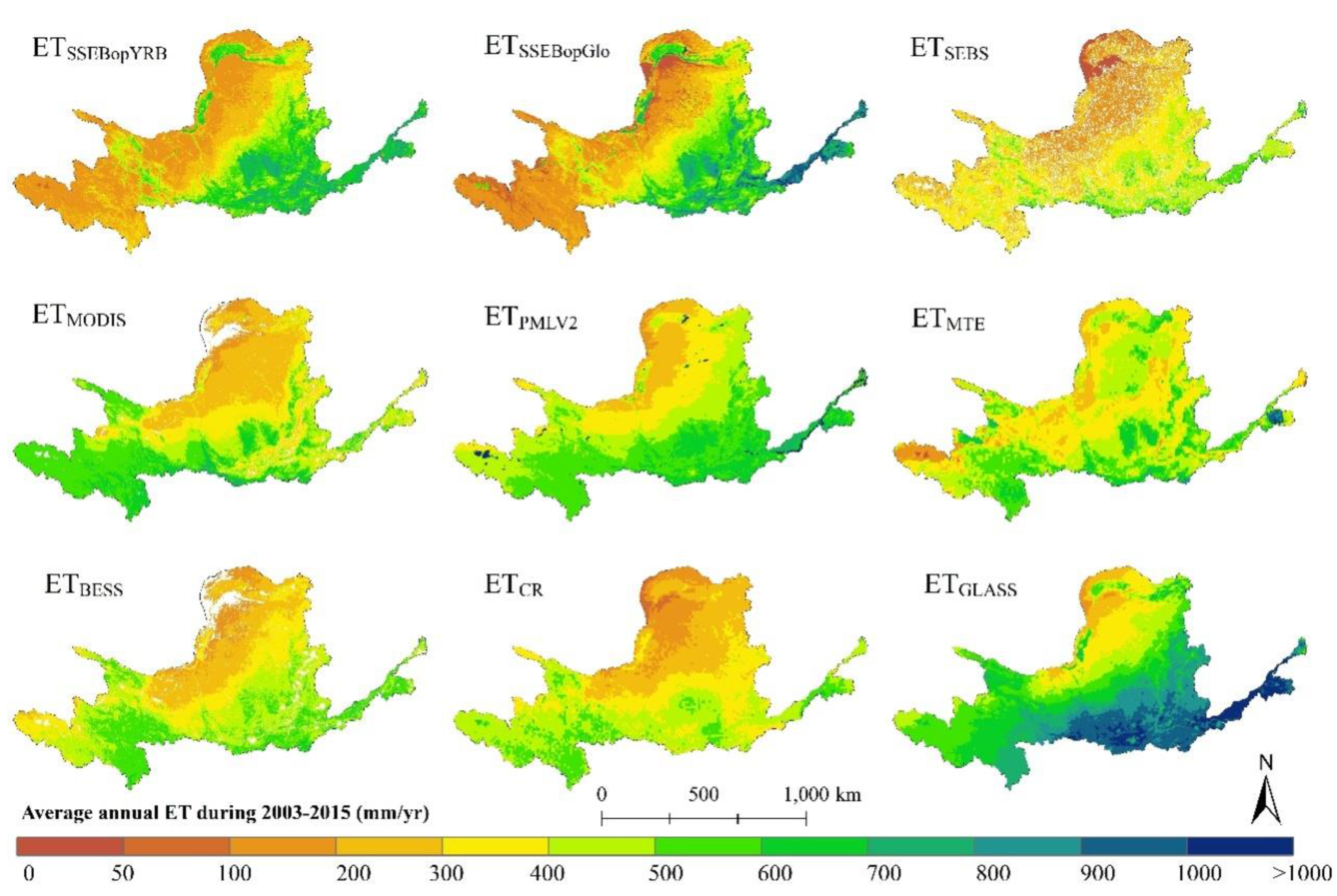
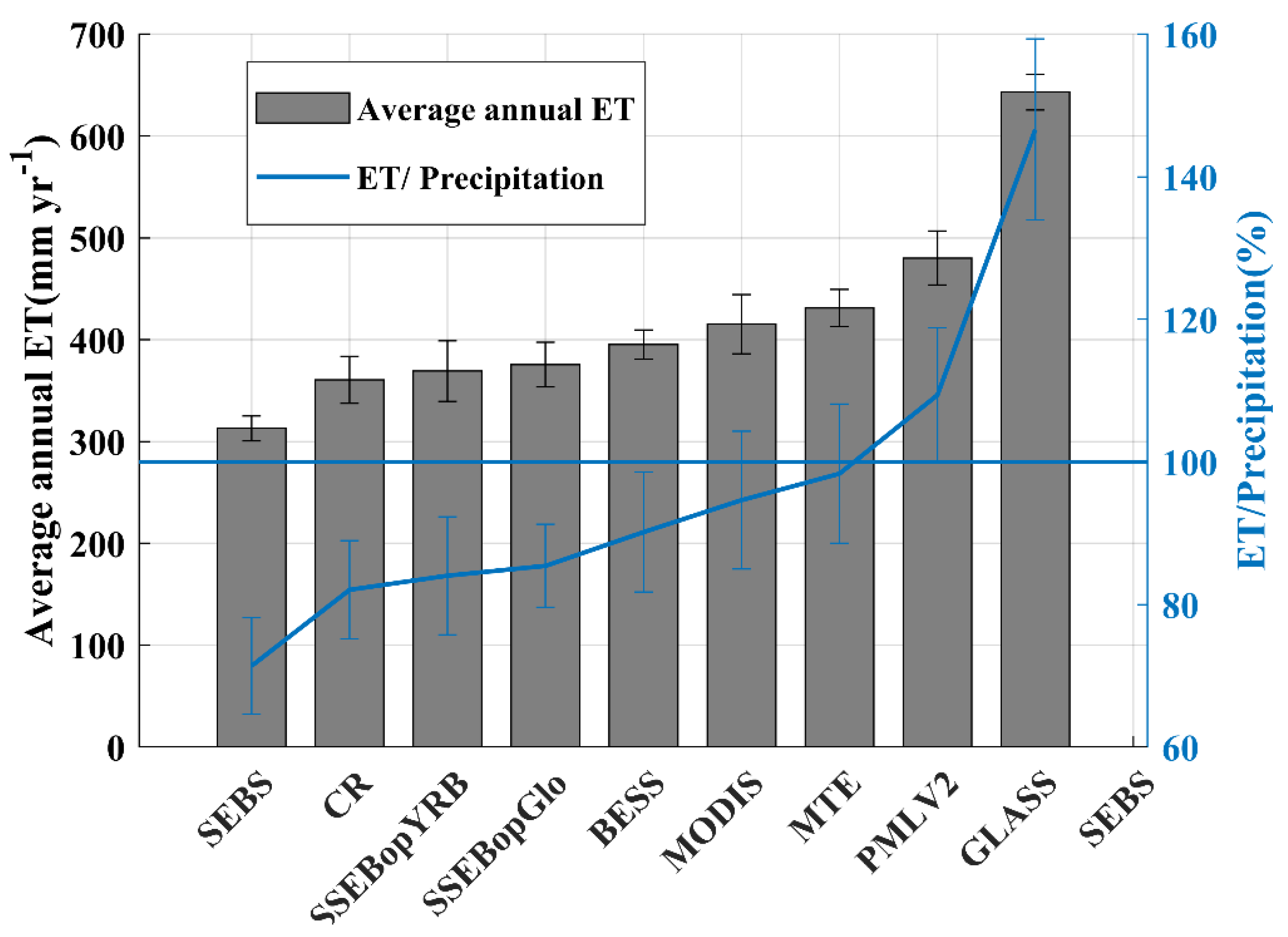
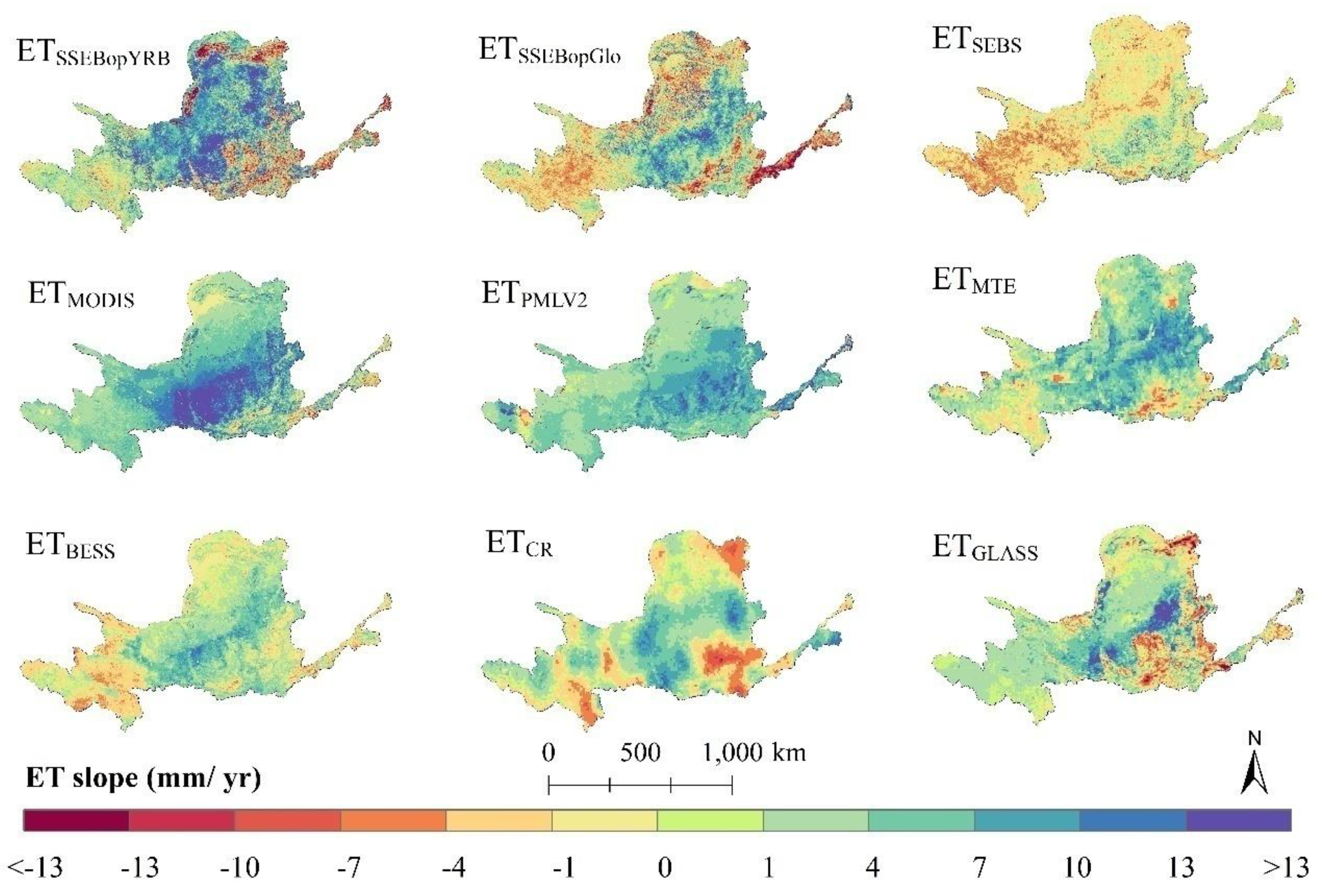
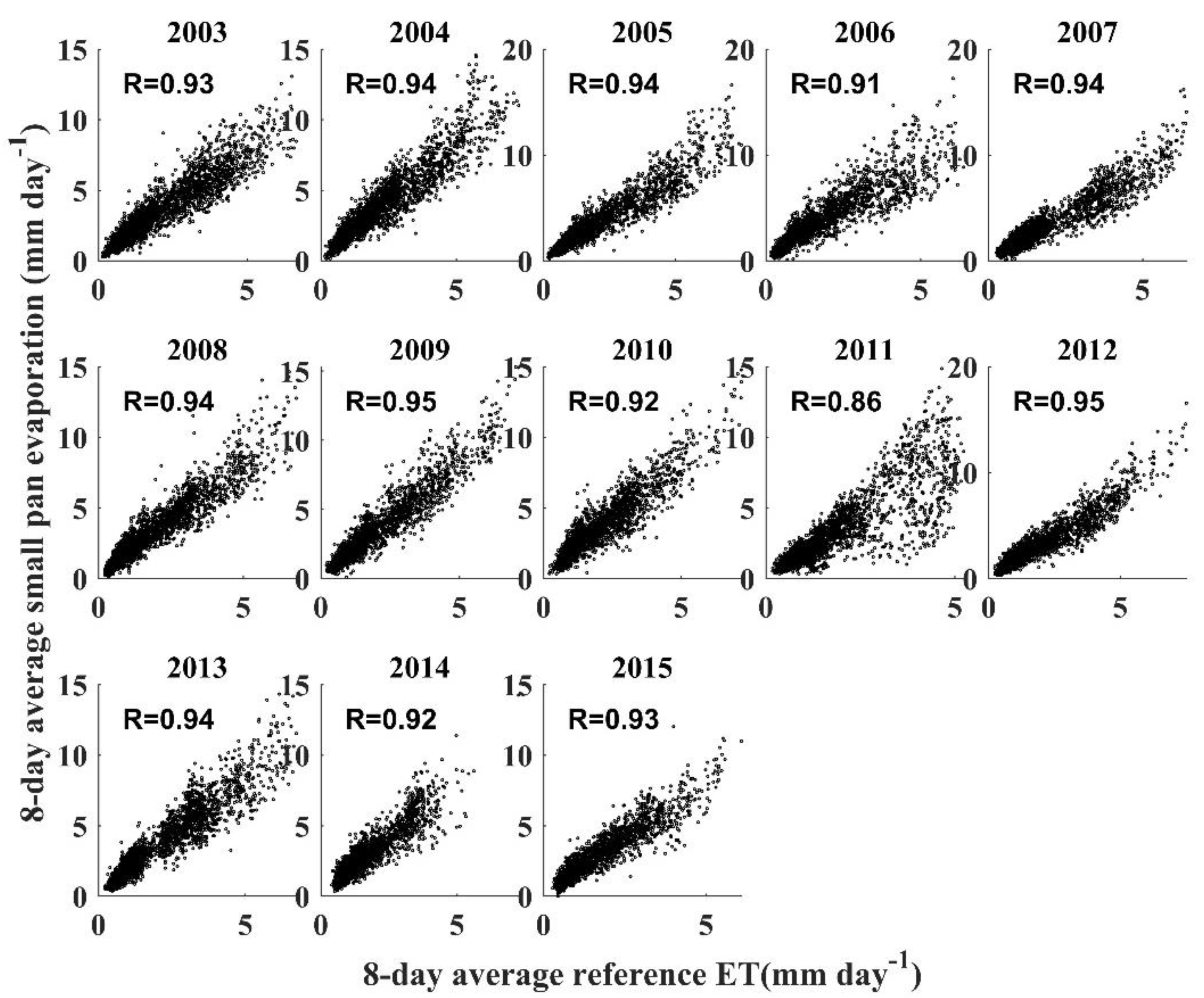
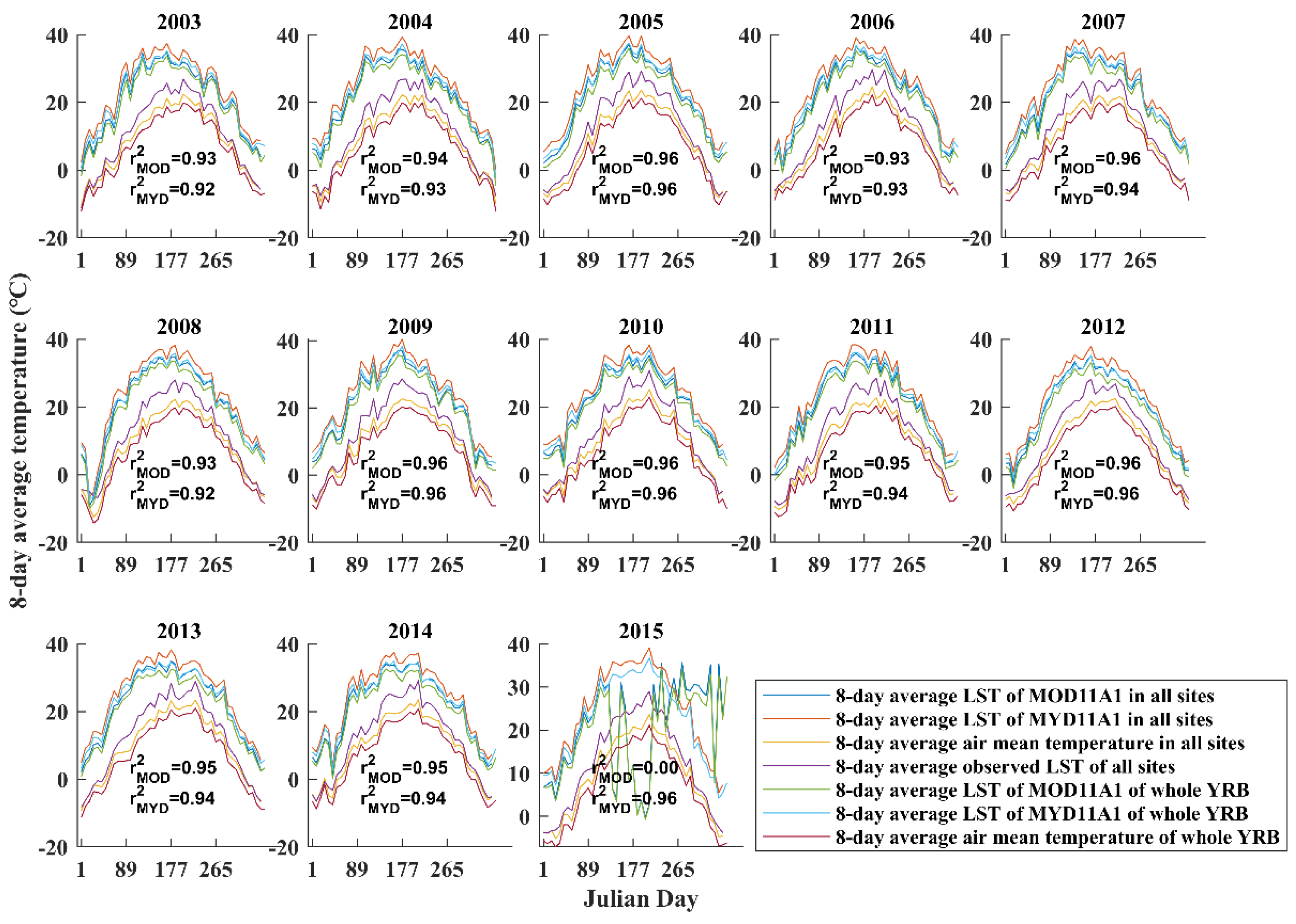
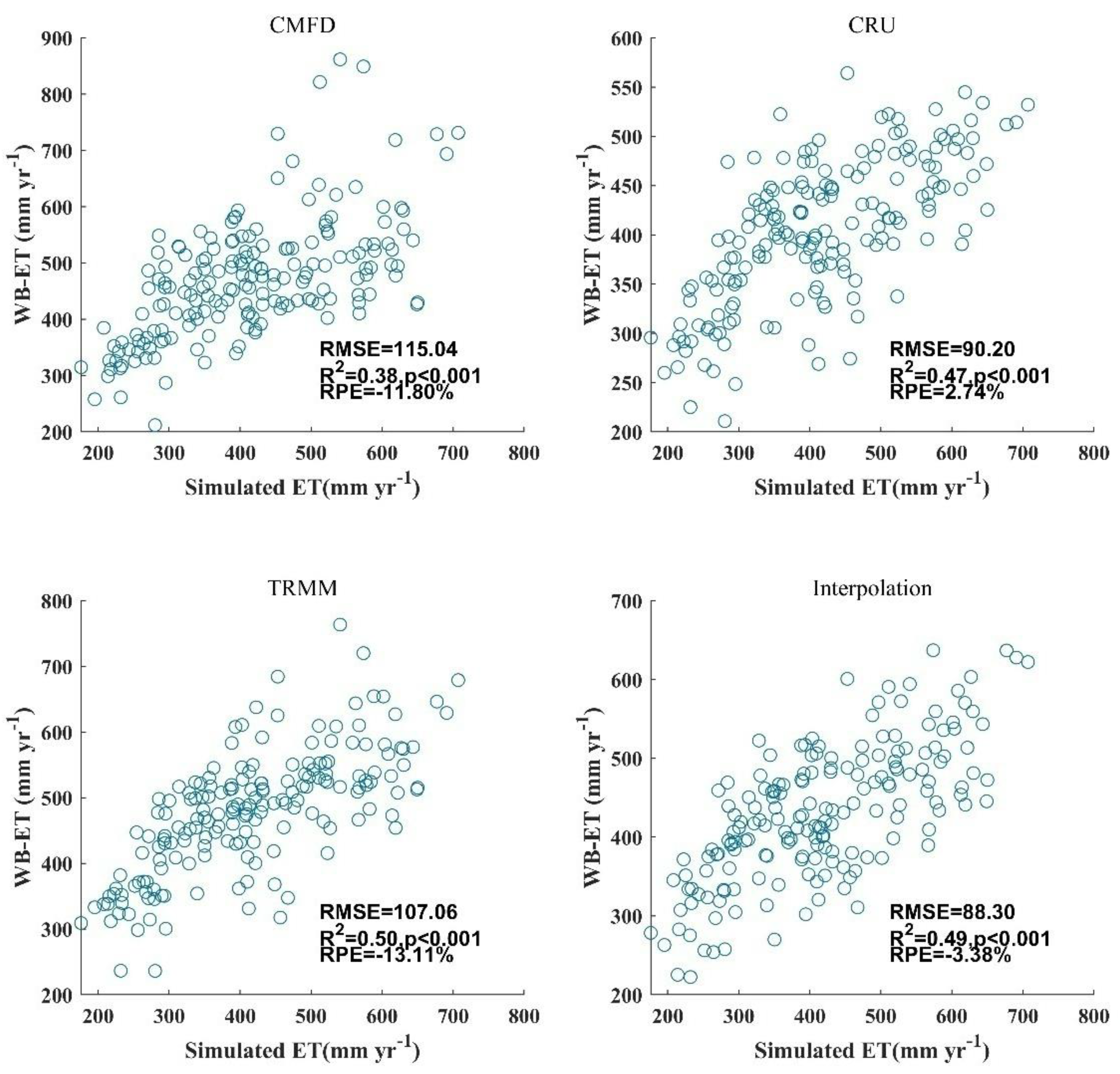
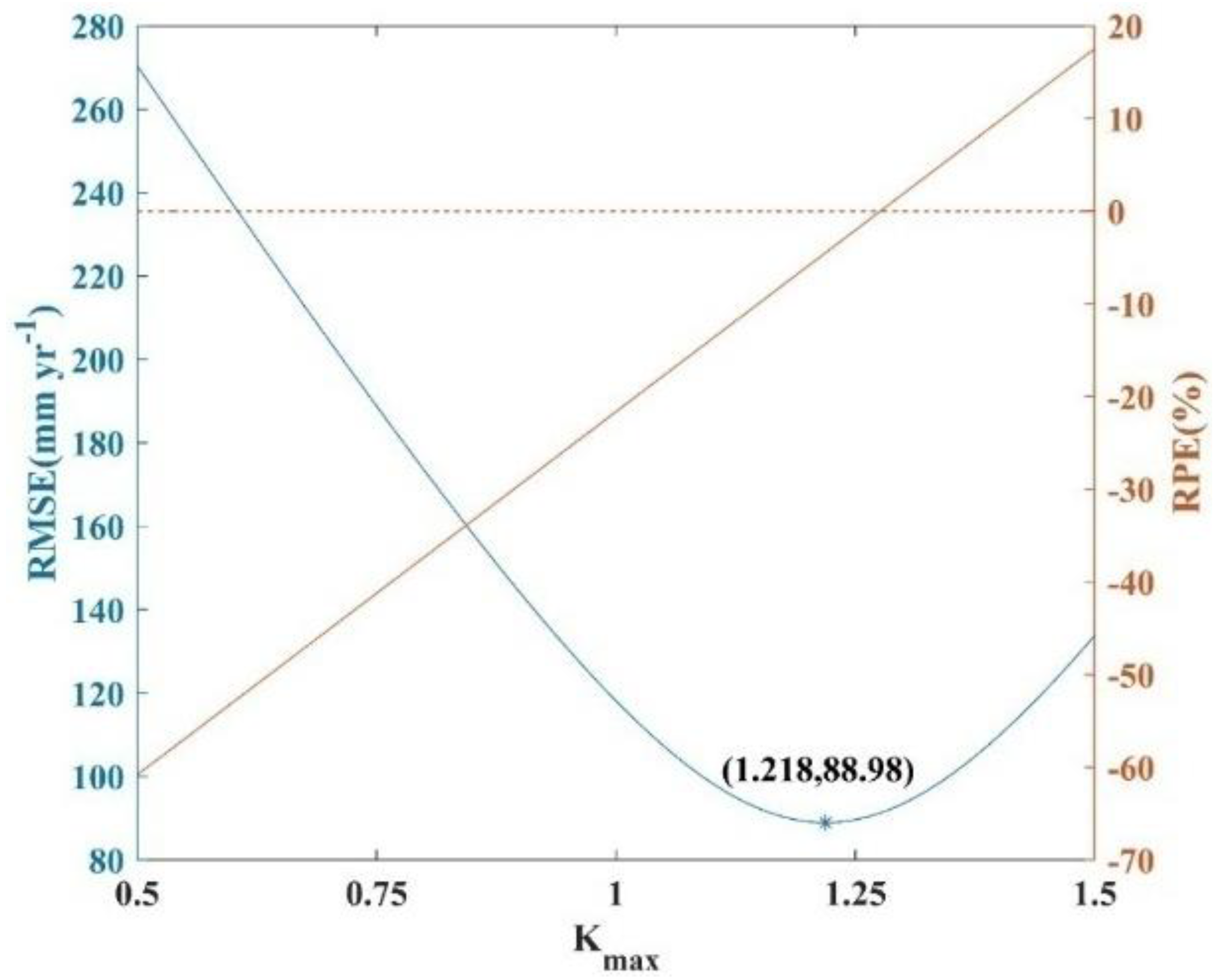
| Name | Time Period | Method | Resolution | Data Source |
|---|---|---|---|---|
| ETMTE | 1982–2015 | Upscaling | 0.1°/month | Li et al. 2018 |
| ETCR | 1982–2015 | CR | 0.1°/month | http://www.tpedatabase.cn |
| ETMODIS | 2001–2019 | RS-PM | 500 m/8 days | https://modis.gsfc.nasa.gov/data/dataprod/mod16.php |
| ETSSEBopGlo | 2003–2019 | SEB | 1 km/month | https://earlywarning.usgs.gov/ |
| ETBESS | 2001–2015 | RS-PM | 1 km/8 days | http://environment.snu.ac.kr/ |
| ETSEBS | 2001–2016 | SEB | 0.05°/day | http://www.tpedatabase.cn |
| ETGLASS | 2001–2015 | BMA | 0.05°/8 days | http://www.geodata.cn |
| ETPMLV2 | 2002–2018 | RS-PM | 0.05°/8 days | http://www.tpdc.ac.cn/ |
| Hydrological Station | Station Location | Catchment Area (km2) | Annual Runoff (108 m3) | Annual Precipitation (mm) |
|---|---|---|---|---|
| DaNing | 110.71 E, 36.46 N | 4186 | 0.84 | 514 |
| DingJiaGou | 110.25 E, 37.55 N | 41948 | 6.70 | 339 |
| GanGuYi | 109.8 E, 36.7 N | 5857 | 1.51 | 482 |
| GaoJiaChuan | 110.48 E, 35.56 N | 4955 | 2.14 | 378 |
| GaoShiYa | 111.13 E, 38.93 N | 1260 | 0.18 | 399 |
| Hejing | 110.8 E, 35.56 N | 39186 | 5.07 | 486 |
| HuangFu | 111.08 E, 39.28 N | 3230 | 0.36 | 375 |
| ShenJiaWan | 110.48 E, 38.03 N | 1138 | 0.33 | 405 |
| SuiDe | 110.23 E, 37.5 N | 3861 | 1.07 | 416 |
| WenJiaChuan | 110.75 E, 38.43 N | 8621 | 2.17 | 373 |
| YanChuan | 110.18 E, 36.8 N | 2095 | 0.98 | 458 |
| ZhangJiaShan | 108.6 E, 34.63 N | 43106 | 10.32 | 484 |
| ZhuangTou | 109.83 E, 35.03 N | 25645 | 0.21 | 519 |
| ET Product | R2 | RMSE (mm yr−1) | RPE (%) |
|---|---|---|---|
| ETSEBS | 0.95 | 125.32 | −28.73 |
| ETBESS | 0.87 | 54.02 | −11.62 |
| ETSSEBopYRB | 0.85 | 60.09 | −3.38 |
| ETSSEBopGlo | 0.84 | 63.25 | 3.01 |
| ETGLASS | 0.79 | 224.73 | 44.59 |
| ETCR | 0.70 | 120.38 | −26.54 |
| ETPMLv2 | 0.69 | 44.00 | 5.28 |
| ETMODIS | 0.65 | 105.45 | −19.97 |
| ETMTE | 0.17 | 58.31 | −4.11 |
| ET Product | ET Slope (mm yr−1) | Significant Increase (%) | Significant Decrease (%) | Non-Significant Increase (%) | Non-Significant Decrease (%) |
|---|---|---|---|---|---|
| ETMODIS | 6.61 * | 58.16 | 0.72 | 37.90 | 3.21 |
| ETPMLv2 | 5.16 * | 53.50 | 0.36 | 43.53 | 2.60 |
| ETSSEBopYRB | 4.34 * | 12.74 | 1.16 | 62.50 | 23.60 |
| ETMTE | 3.35 * | 35.28 | 1.19 | 45.47 | 18.07 |
| ETGLASS | 1.78 | 16.88 | 5.83 | 55.19 | 22.10 |
| ETBESS | 1.59 | 22.21 | 4.43 | 45.67 | 27.69 |
| ETCR | 1.24 | 12.00 | 1.19 | 50.38 | 36.43 |
| ETSSEBopGlo | 0.92 | 9.30 | 5.85 | 44.02 | 40.83 |
| ETSEBS | -1.05 | 2.63 | 11.03 | 31.07 | 55.26 |
© 2020 by the authors. Licensee MDPI, Basel, Switzerland. This article is an open access article distributed under the terms and conditions of the Creative Commons Attribution (CC BY) license (http://creativecommons.org/licenses/by/4.0/).
Share and Cite
Yin, L.; Wang, X.; Feng, X.; Fu, B.; Chen, Y. A Comparison of SSEBop-Model-Based Evapotranspiration with Eight Evapotranspiration Products in the Yellow River Basin, China. Remote Sens. 2020, 12, 2528. https://doi.org/10.3390/rs12162528
Yin L, Wang X, Feng X, Fu B, Chen Y. A Comparison of SSEBop-Model-Based Evapotranspiration with Eight Evapotranspiration Products in the Yellow River Basin, China. Remote Sensing. 2020; 12(16):2528. https://doi.org/10.3390/rs12162528
Chicago/Turabian StyleYin, Lichang, Xiaofeng Wang, Xiaoming Feng, Bojie Fu, and Yongzhe Chen. 2020. "A Comparison of SSEBop-Model-Based Evapotranspiration with Eight Evapotranspiration Products in the Yellow River Basin, China" Remote Sensing 12, no. 16: 2528. https://doi.org/10.3390/rs12162528






